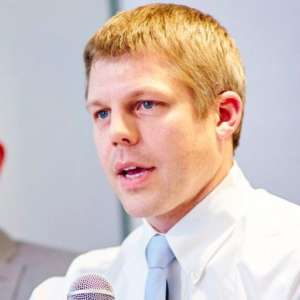 Exclusive
Exclusive  Exclusive
Exclusive Eddie Hartwig, the acting deputy administrator of U.S. Digital Service, said his office has changed its approach over the past year.
While early USDS efforts may have rubbed some people the wrong way, the organization is maturing and improving its approach to improving federal services.
Eddie Hartwig, the acting deputy administrator of USDS, said there are several reasons why his office has changed its approach over the past year.

“The best analogy someone on my team recently gave me is that when we first joined up on this endeavor, we came in as firefighters. We were often times called in to solve major problems, something that is out of control. And we played that role,” Hartwig said on Ask the CIO. “These days we don’t play that role as often as we play the role of Smokey Bear, which is we are looking to prevent fires by working with the agency teams to identify things before they become a problem. Sometimes that doesn’t look as great on paper, but in reality it does a lot more good for the public if we can prevent problems from happening in the first place.”
The Obama administration created USDS in August 2014 with the idea that the lessons learned from fixing the healthcare.gov website debacle could live on. At the time, the federal chief information officer Steve VanRoekel said USDS would be an “IT SWAT” team of sorts, made up of 20-25 people who apply technology in smarter, more effective ways that improve the delivery of federal services, information and benefits.
Over the next two-plus years, USDS grew to nearly 200 people and, some say, became too powerful, working outside the typical processes and not necessarily aligning to meet agency needs.
Hartwig said USDS has adjusted its approach to working with agencies and federal CIOs over the last year or so.
“Our goal is to work alongside CIOs and help them deliver services. We have the same goal,” he said. “This is about good government. This is delivering services to the government. I work with CIOs every day. I think the relationships are good. Yes, there are times when we disagree on the way forward, but that’s what adults do and that’s how you get to the right conclusion. Sometimes in the end, the CIO is correct and sometimes in the end the CIO agrees the digital service team is correct. But the point is, we are working together to deliver products that make the experience of being a citizen in the United States better.”
He said the goal of USDS is to make those simple changes that improve citizen services.
“The impact we see in our work is not about the cool technology, but delivering the service to the people who need it,” he said. “The primary focus of USDS is on the public. We take projects that either directly engage with the public or directly impact the public. That narrow perspective helps us hone in on what we can do and I think that, in the end, is a valuable resource for CIOs, who can get that user-centered perspective on their services at their agency.”
This more directed emphasis of USDS is detailed in its annual report to Congress.
The report described USDS’ efforts on 11 projects, including HealthCare.gov, IRS’ Get Transcript cyber breach and the Defense Department’s travel system upgrade.
“The central focus of USDS is on the measurable improvement of the performance and cost-effectiveness of important, public-facing federal government digital services — via the application of modern technology best practices,” the report stated. “USDS has developed procedures and criteria for prioritizing projects, which includes obtaining input from OMB’s IT Dashboard, agency leadership, and relevant U.S. Government Accountability Office (GAO) reports.”
Hartwig said one of USDS’ biggest success stories is its work with the Veterans Affairs Department on its Vets.gov portal, a way for veterans to discover, apply for, track and manage their benefits, instead of visiting numerous websites with multiple logins to have their benefits explained to them.
“The keys to Vets.gov success is one, it’s a great idea. You’ve got a population of people who weren’t able to reach the services they needed, and we made it easier for them to do that. It’s a simple idea to say that out loud, but it’s not always easy to execute on, especially in an apparatus as large as the Department of Veterans Affairs,” he said. “What is driving the success of Vets.gov and our other programs at the Department of Veterans Affairs are the relationships we’ve built and the fact we’ve been engaged with VA for so long has allowed us to scale all of our projects there. We’ve built trust. We are working closely with the CIO, the CTO and the executive office to make sure all of our outcomes are aligned.”
Hartwig said another project that didn’t make the annual report to Congress is a new project with the Centers for Medicare and Medicaid Services. USDS and CMS worked on a new set of application programming interfaces (APIs) for internal and external users that will let the agency grow its services.
“The APIs help the government connect data streams to one another. They are the building blocks of how modern systems are built,” he said. “We are building a government that can scale in a modern way alongside businesses and we are engaging the public and private sector in that process. We are enabling the private sector to work with us and not alongside us in sort of a blind spot.”
Hartwig said USDS decides on what projects to work on based on a set of criteria that starts with the simple idea of whether the program is a public facing service.
“There’s a whole bunch of government IT that the public never sees. That’s not where we work. We aren’t here to fix people’s email,” he said. “We follow three basic criteria. We work on projects that do the most good, for the most people in the greatest need. That impact statement is really key for us. Sometimes that means we work on a project that affects 100 million Americans or we work on a project for veterans that affects 30 million Americans, but those 30 million Americans are getting a heck of a lot more out of service than the general public would out of a less valuable service. So it’s both about the number and the quality of product we can deliver and the people who we deliver it to. Criteria number 2 is that we have the strong support from the agency’s lead. Our goal is to get that strong secretarial or deputy secretarial support so that we have the freedom to work across the agency, to meet with users, to meet with people who deliver services and really design a really user-centric product.”
Hartwig added a third criteria is scalability and reusability for other agencies.
Over the next year, Hartwig said USDS will focus on continuing to deliver services to current customers, as well as growing a team at the Small Business Administration and working on acquisition training to help agencies buy agile technology.
Copyright © 2025 Federal News Network. All rights reserved. This website is not intended for users located within the European Economic Area.
Jason Miller is executive editor of Federal News Network and directs news coverage on the people, policy and programs of the federal government.
Follow @jmillerWFED
 Exclusive
Exclusive 
